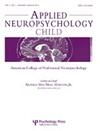LITMUS Turkish sentence repetition test: The best items, effect of scoring and diagnostic accuracy.
IF 1.4
4区 心理学
Q4 CLINICAL NEUROLOGY
引用次数: 0
Abstract
PURPOSE This study aimed to examine LITMUS Turkish Sentence Repetition Test's (LITMUS-TR) diagnostic accuracy, as well as the best scoring method and most distinguishing test items. We also sought to ascertain whether age has an impact on the sensitivity and specificity. METHOD Two hundred and fifty children with typical language development (TD) between the ages of 4 and 7, as well as 44 children with developmental language disorder (DLD), took part in the study. Data was collected using TODİL, LITMUS-TR, and the pediatric family interview form. LITMUS-TR was graded using four different methods. RESULTS The performance of children with DLD in each score type was lower and the number of errors higher than those with TD. All items have excellent or acceptable item difficulty and discrimination values for binary scoring and total number of errors. LITMUS-TR's most distinctive items were complex structures with dependencies, such as syntactic movement and embedding. LITMUS-TR had high diagnostic accuracy for the whole test (0.887) and each scoring method. A separate analysis of each age group showed sensitivity and specificity above 0.80. CONCLUSIONS When employed as a supportive objective measure, LITMUS-TR was proven to be an effective diagnostic tool for DLD, with age influencing the diagnostic accuracy outcomes.LITMUS 土耳其语句子重复测试:最佳项目、评分效果和诊断准确性。
目的本研究旨在探讨 LITMUS 土耳其语句子重复测试(LITMUS-TR)的诊断准确性、最佳评分方法和最易区分的测试项目。方法250名年龄在4至7岁之间的典型语言发育(TD)儿童和44名发育性语言障碍(DLD)儿童参加了研究。研究使用TODİL、LITMUS-TR和儿科家庭访谈表收集数据。结果DLD患儿在每种评分类型中的表现均低于TD患儿,错误次数也高于TD患儿。在二元计分和错误总数方面,所有项目的项目难度和区分度值都很好或可以接受。LITMUS-TR 最具特色的项目是具有依赖关系的复杂结构,如句法移动和嵌入。LITMUS-TR 在整个测试(0.887)和每种计分方法上都具有很高的诊断准确性。结论LITMUS-TR作为一种辅助性客观测量方法,被证明是一种有效的DLD诊断工具,其诊断准确性结果受年龄的影响。
本文章由计算机程序翻译,如有差异,请以英文原文为准。
求助全文
约1分钟内获得全文
求助全文
来源期刊

Applied Neuropsychology: Child
CLINICAL NEUROLOGY-PSYCHOLOGY
CiteScore
4.00
自引率
5.90%
发文量
47
期刊介绍:
Applied Neuropsychology: Child publishes clinical neuropsychological articles concerning assessment, brain functioning and neuroimaging, neuropsychological treatment, and rehabilitation in children. Full-length articles and brief communications are included. Case studies of child patients carefully assessing the nature, course, or treatment of clinical neuropsychological dysfunctions in the context of scientific literature, are suitable. Review manuscripts addressing critical issues are encouraged. Preference is given to papers of clinical relevance to others in the field. All submitted manuscripts are subject to initial appraisal by the Editor-in-Chief, and, if found suitable for further considerations are peer reviewed by independent, anonymous expert referees. All peer review is single-blind and submission is online via ScholarOne Manuscripts.
 求助内容:
求助内容: 应助结果提醒方式:
应助结果提醒方式:


